Economic Report: Analysis of Australian Monetary and Fiscal Policies
VerifiedAdded on 2023/01/17
|12
|3809
|56
Report
AI Summary
This report provides an in-depth analysis of the Australian economy, focusing on its current trends, monetary and fiscal policies, and the impact of the cash rate. It examines the Australian economy's strengths, including its strong market economy and diverse sectors, while also addressing challenges such as slowing growth and declining household consumption. The report details the roles of the Reserve Bank of Australia (RBA) in monetary policy, including the recent reduction of the cash rate to 1%, and the government's fiscal policies. It evaluates the effectiveness of these policies in addressing issues such as inflation, unemployment, and slow economic growth, and the measures taken by the governor for improving the policy. The analysis highlights the need for stimulus to boost the economy and improve economic indicators. This report provides a comprehensive overview of the Australian economy and its key drivers.

ECONOMIC PRINCIPLES &
DECISION-MAKING
(REPORT)
DECISION-MAKING
(REPORT)
Paraphrase This Document
Need a fresh take? Get an instant paraphrase of this document with our AI Paraphraser

TABLE OF CONTENTS
INTRODUCTION...........................................................................................................................1
MAIN BODY...................................................................................................................................1
Australian Economy.....................................................................................................................1
Current Trends of Australian Economy. .....................................................................................2
Monetary policy...........................................................................................................................3
Fiscal policy ................................................................................................................................5
Cash Rate ....................................................................................................................................5
Cut of Cash Rate to 1 % ..............................................................................................................6
Effectiveness of monetary and fiscal policies. ............................................................................7
CONCLUSION................................................................................................................................8
REFERENCES................................................................................................................................9
INTRODUCTION...........................................................................................................................1
MAIN BODY...................................................................................................................................1
Australian Economy.....................................................................................................................1
Current Trends of Australian Economy. .....................................................................................2
Monetary policy...........................................................................................................................3
Fiscal policy ................................................................................................................................5
Cash Rate ....................................................................................................................................5
Cut of Cash Rate to 1 % ..............................................................................................................6
Effectiveness of monetary and fiscal policies. ............................................................................7
CONCLUSION................................................................................................................................8
REFERENCES................................................................................................................................9
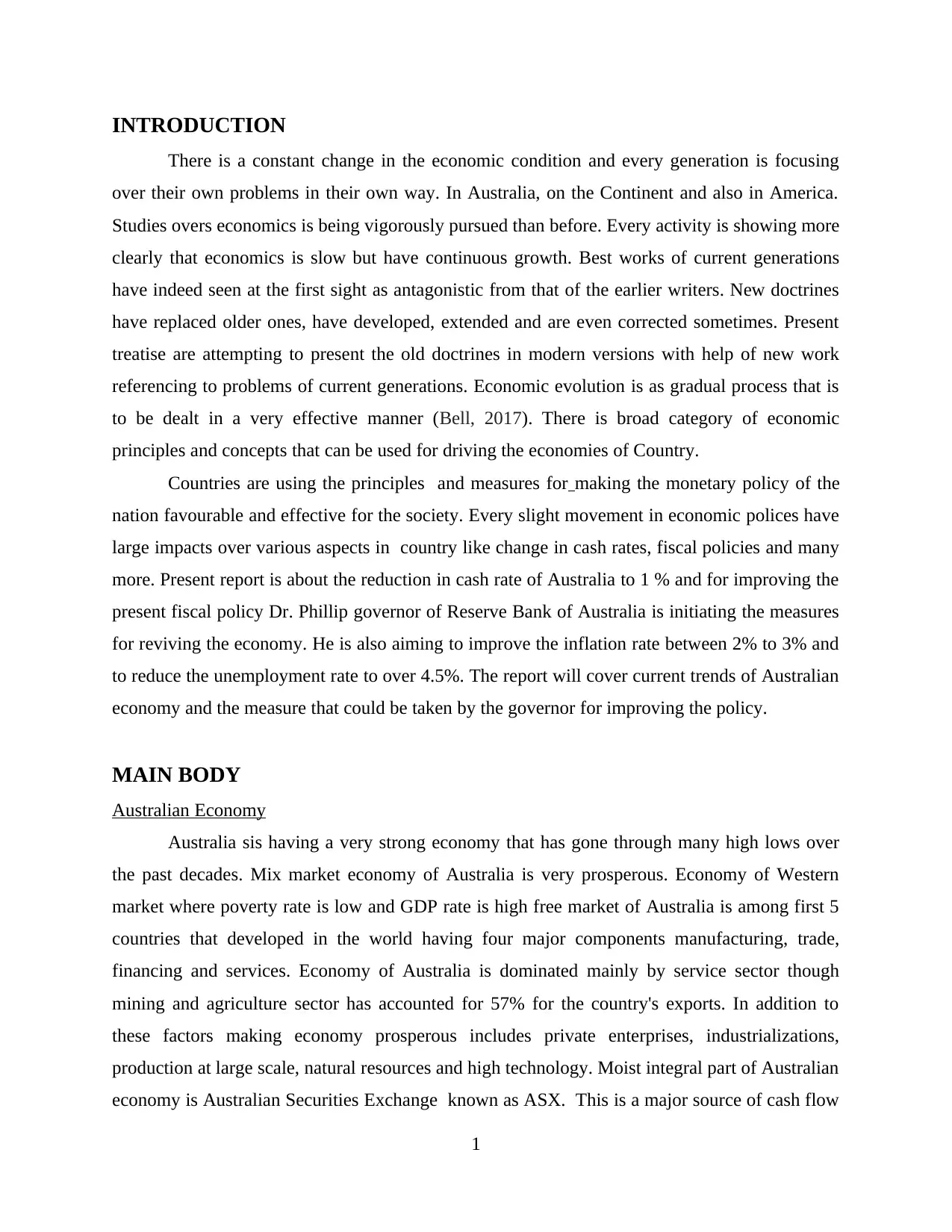
INTRODUCTION
There is a constant change in the economic condition and every generation is focusing
over their own problems in their own way. In Australia, on the Continent and also in America.
Studies overs economics is being vigorously pursued than before. Every activity is showing more
clearly that economics is slow but have continuous growth. Best works of current generations
have indeed seen at the first sight as antagonistic from that of the earlier writers. New doctrines
have replaced older ones, have developed, extended and are even corrected sometimes. Present
treatise are attempting to present the old doctrines in modern versions with help of new work
referencing to problems of current generations. Economic evolution is as gradual process that is
to be dealt in a very effective manner (Bell, 2017). There is broad category of economic
principles and concepts that can be used for driving the economies of Country.
Countries are using the principles and measures for making the monetary policy of the
nation favourable and effective for the society. Every slight movement in economic polices have
large impacts over various aspects in country like change in cash rates, fiscal policies and many
more. Present report is about the reduction in cash rate of Australia to 1 % and for improving the
present fiscal policy Dr. Phillip governor of Reserve Bank of Australia is initiating the measures
for reviving the economy. He is also aiming to improve the inflation rate between 2% to 3% and
to reduce the unemployment rate to over 4.5%. The report will cover current trends of Australian
economy and the measure that could be taken by the governor for improving the policy.
MAIN BODY
Australian Economy
Australia sis having a very strong economy that has gone through many high lows over
the past decades. Mix market economy of Australia is very prosperous. Economy of Western
market where poverty rate is low and GDP rate is high free market of Australia is among first 5
countries that developed in the world having four major components manufacturing, trade,
financing and services. Economy of Australia is dominated mainly by service sector though
mining and agriculture sector has accounted for 57% for the country's exports. In addition to
these factors making economy prosperous includes private enterprises, industrializations,
production at large scale, natural resources and high technology. Moist integral part of Australian
economy is Australian Securities Exchange known as ASX. This is a major source of cash flow
1
There is a constant change in the economic condition and every generation is focusing
over their own problems in their own way. In Australia, on the Continent and also in America.
Studies overs economics is being vigorously pursued than before. Every activity is showing more
clearly that economics is slow but have continuous growth. Best works of current generations
have indeed seen at the first sight as antagonistic from that of the earlier writers. New doctrines
have replaced older ones, have developed, extended and are even corrected sometimes. Present
treatise are attempting to present the old doctrines in modern versions with help of new work
referencing to problems of current generations. Economic evolution is as gradual process that is
to be dealt in a very effective manner (Bell, 2017). There is broad category of economic
principles and concepts that can be used for driving the economies of Country.
Countries are using the principles and measures for making the monetary policy of the
nation favourable and effective for the society. Every slight movement in economic polices have
large impacts over various aspects in country like change in cash rates, fiscal policies and many
more. Present report is about the reduction in cash rate of Australia to 1 % and for improving the
present fiscal policy Dr. Phillip governor of Reserve Bank of Australia is initiating the measures
for reviving the economy. He is also aiming to improve the inflation rate between 2% to 3% and
to reduce the unemployment rate to over 4.5%. The report will cover current trends of Australian
economy and the measure that could be taken by the governor for improving the policy.
MAIN BODY
Australian Economy
Australia sis having a very strong economy that has gone through many high lows over
the past decades. Mix market economy of Australia is very prosperous. Economy of Western
market where poverty rate is low and GDP rate is high free market of Australia is among first 5
countries that developed in the world having four major components manufacturing, trade,
financing and services. Economy of Australia is dominated mainly by service sector though
mining and agriculture sector has accounted for 57% for the country's exports. In addition to
these factors making economy prosperous includes private enterprises, industrializations,
production at large scale, natural resources and high technology. Moist integral part of Australian
economy is Australian Securities Exchange known as ASX. This is a major source of cash flow
1
⊘ This is a preview!⊘
Do you want full access?
Subscribe today to unlock all pages.

Trusted by 1+ million students worldwide
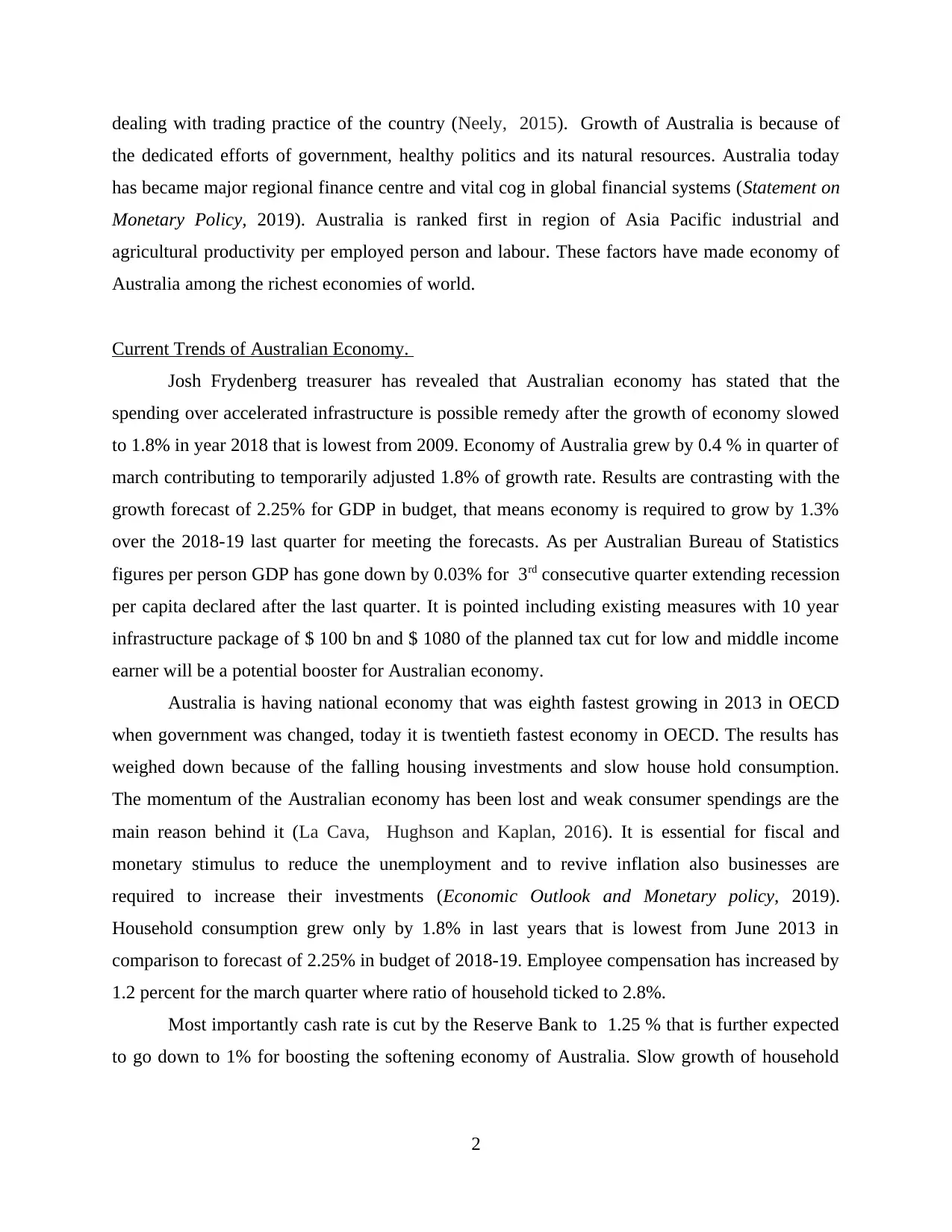
dealing with trading practice of the country (Neely, 2015). Growth of Australia is because of
the dedicated efforts of government, healthy politics and its natural resources. Australia today
has became major regional finance centre and vital cog in global financial systems (Statement on
Monetary Policy, 2019). Australia is ranked first in region of Asia Pacific industrial and
agricultural productivity per employed person and labour. These factors have made economy of
Australia among the richest economies of world.
Current Trends of Australian Economy.
Josh Frydenberg treasurer has revealed that Australian economy has stated that the
spending over accelerated infrastructure is possible remedy after the growth of economy slowed
to 1.8% in year 2018 that is lowest from 2009. Economy of Australia grew by 0.4 % in quarter of
march contributing to temporarily adjusted 1.8% of growth rate. Results are contrasting with the
growth forecast of 2.25% for GDP in budget, that means economy is required to grow by 1.3%
over the 2018-19 last quarter for meeting the forecasts. As per Australian Bureau of Statistics
figures per person GDP has gone down by 0.03% for 3rd consecutive quarter extending recession
per capita declared after the last quarter. It is pointed including existing measures with 10 year
infrastructure package of $ 100 bn and $ 1080 of the planned tax cut for low and middle income
earner will be a potential booster for Australian economy.
Australia is having national economy that was eighth fastest growing in 2013 in OECD
when government was changed, today it is twentieth fastest economy in OECD. The results has
weighed down because of the falling housing investments and slow house hold consumption.
The momentum of the Australian economy has been lost and weak consumer spendings are the
main reason behind it (La Cava, Hughson and Kaplan, 2016). It is essential for fiscal and
monetary stimulus to reduce the unemployment and to revive inflation also businesses are
required to increase their investments (Economic Outlook and Monetary policy, 2019).
Household consumption grew only by 1.8% in last years that is lowest from June 2013 in
comparison to forecast of 2.25% in budget of 2018-19. Employee compensation has increased by
1.2 percent for the march quarter where ratio of household ticked to 2.8%.
Most importantly cash rate is cut by the Reserve Bank to 1.25 % that is further expected
to go down to 1% for boosting the softening economy of Australia. Slow growth of household
2
the dedicated efforts of government, healthy politics and its natural resources. Australia today
has became major regional finance centre and vital cog in global financial systems (Statement on
Monetary Policy, 2019). Australia is ranked first in region of Asia Pacific industrial and
agricultural productivity per employed person and labour. These factors have made economy of
Australia among the richest economies of world.
Current Trends of Australian Economy.
Josh Frydenberg treasurer has revealed that Australian economy has stated that the
spending over accelerated infrastructure is possible remedy after the growth of economy slowed
to 1.8% in year 2018 that is lowest from 2009. Economy of Australia grew by 0.4 % in quarter of
march contributing to temporarily adjusted 1.8% of growth rate. Results are contrasting with the
growth forecast of 2.25% for GDP in budget, that means economy is required to grow by 1.3%
over the 2018-19 last quarter for meeting the forecasts. As per Australian Bureau of Statistics
figures per person GDP has gone down by 0.03% for 3rd consecutive quarter extending recession
per capita declared after the last quarter. It is pointed including existing measures with 10 year
infrastructure package of $ 100 bn and $ 1080 of the planned tax cut for low and middle income
earner will be a potential booster for Australian economy.
Australia is having national economy that was eighth fastest growing in 2013 in OECD
when government was changed, today it is twentieth fastest economy in OECD. The results has
weighed down because of the falling housing investments and slow house hold consumption.
The momentum of the Australian economy has been lost and weak consumer spendings are the
main reason behind it (La Cava, Hughson and Kaplan, 2016). It is essential for fiscal and
monetary stimulus to reduce the unemployment and to revive inflation also businesses are
required to increase their investments (Economic Outlook and Monetary policy, 2019).
Household consumption grew only by 1.8% in last years that is lowest from June 2013 in
comparison to forecast of 2.25% in budget of 2018-19. Employee compensation has increased by
1.2 percent for the march quarter where ratio of household ticked to 2.8%.
Most importantly cash rate is cut by the Reserve Bank to 1.25 % that is further expected
to go down to 1% for boosting the softening economy of Australia. Slow growth of household
2
Paraphrase This Document
Need a fresh take? Get an instant paraphrase of this document with our AI Paraphraser
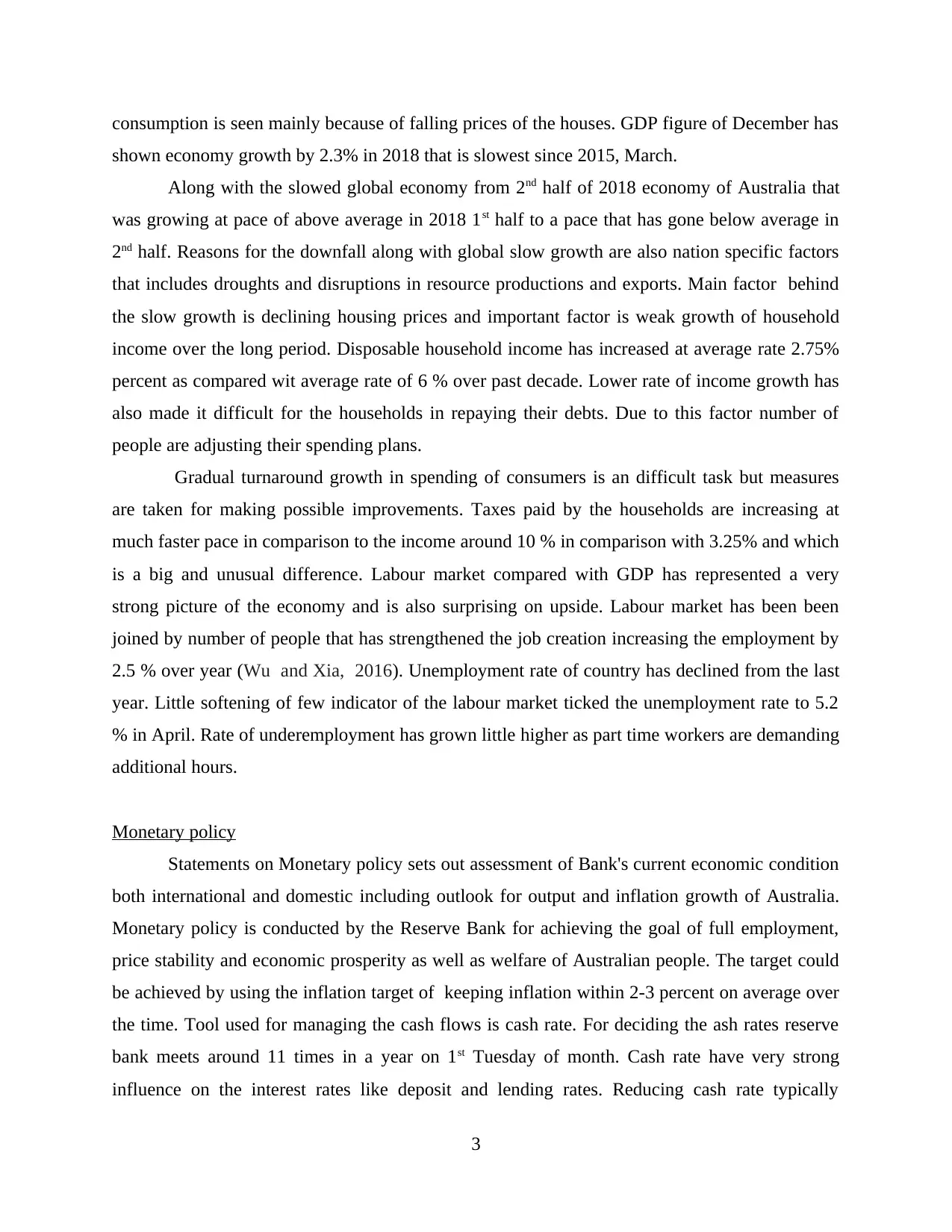
consumption is seen mainly because of falling prices of the houses. GDP figure of December has
shown economy growth by 2.3% in 2018 that is slowest since 2015, March.
Along with the slowed global economy from 2nd half of 2018 economy of Australia that
was growing at pace of above average in 2018 1st half to a pace that has gone below average in
2nd half. Reasons for the downfall along with global slow growth are also nation specific factors
that includes droughts and disruptions in resource productions and exports. Main factor behind
the slow growth is declining housing prices and important factor is weak growth of household
income over the long period. Disposable household income has increased at average rate 2.75%
percent as compared wit average rate of 6 % over past decade. Lower rate of income growth has
also made it difficult for the households in repaying their debts. Due to this factor number of
people are adjusting their spending plans.
Gradual turnaround growth in spending of consumers is an difficult task but measures
are taken for making possible improvements. Taxes paid by the households are increasing at
much faster pace in comparison to the income around 10 % in comparison with 3.25% and which
is a big and unusual difference. Labour market compared with GDP has represented a very
strong picture of the economy and is also surprising on upside. Labour market has been been
joined by number of people that has strengthened the job creation increasing the employment by
2.5 % over year (Wu and Xia, 2016). Unemployment rate of country has declined from the last
year. Little softening of few indicator of the labour market ticked the unemployment rate to 5.2
% in April. Rate of underemployment has grown little higher as part time workers are demanding
additional hours.
Monetary policy
Statements on Monetary policy sets out assessment of Bank's current economic condition
both international and domestic including outlook for output and inflation growth of Australia.
Monetary policy is conducted by the Reserve Bank for achieving the goal of full employment,
price stability and economic prosperity as well as welfare of Australian people. The target could
be achieved by using the inflation target of keeping inflation within 2-3 percent on average over
the time. Tool used for managing the cash flows is cash rate. For deciding the ash rates reserve
bank meets around 11 times in a year on 1st Tuesday of month. Cash rate have very strong
influence on the interest rates like deposit and lending rates. Reducing cash rate typically
3
shown economy growth by 2.3% in 2018 that is slowest since 2015, March.
Along with the slowed global economy from 2nd half of 2018 economy of Australia that
was growing at pace of above average in 2018 1st half to a pace that has gone below average in
2nd half. Reasons for the downfall along with global slow growth are also nation specific factors
that includes droughts and disruptions in resource productions and exports. Main factor behind
the slow growth is declining housing prices and important factor is weak growth of household
income over the long period. Disposable household income has increased at average rate 2.75%
percent as compared wit average rate of 6 % over past decade. Lower rate of income growth has
also made it difficult for the households in repaying their debts. Due to this factor number of
people are adjusting their spending plans.
Gradual turnaround growth in spending of consumers is an difficult task but measures
are taken for making possible improvements. Taxes paid by the households are increasing at
much faster pace in comparison to the income around 10 % in comparison with 3.25% and which
is a big and unusual difference. Labour market compared with GDP has represented a very
strong picture of the economy and is also surprising on upside. Labour market has been been
joined by number of people that has strengthened the job creation increasing the employment by
2.5 % over year (Wu and Xia, 2016). Unemployment rate of country has declined from the last
year. Little softening of few indicator of the labour market ticked the unemployment rate to 5.2
% in April. Rate of underemployment has grown little higher as part time workers are demanding
additional hours.
Monetary policy
Statements on Monetary policy sets out assessment of Bank's current economic condition
both international and domestic including outlook for output and inflation growth of Australia.
Monetary policy is conducted by the Reserve Bank for achieving the goal of full employment,
price stability and economic prosperity as well as welfare of Australian people. The target could
be achieved by using the inflation target of keeping inflation within 2-3 percent on average over
the time. Tool used for managing the cash flows is cash rate. For deciding the ash rates reserve
bank meets around 11 times in a year on 1st Tuesday of month. Cash rate have very strong
influence on the interest rates like deposit and lending rates. Reducing cash rate typically
3
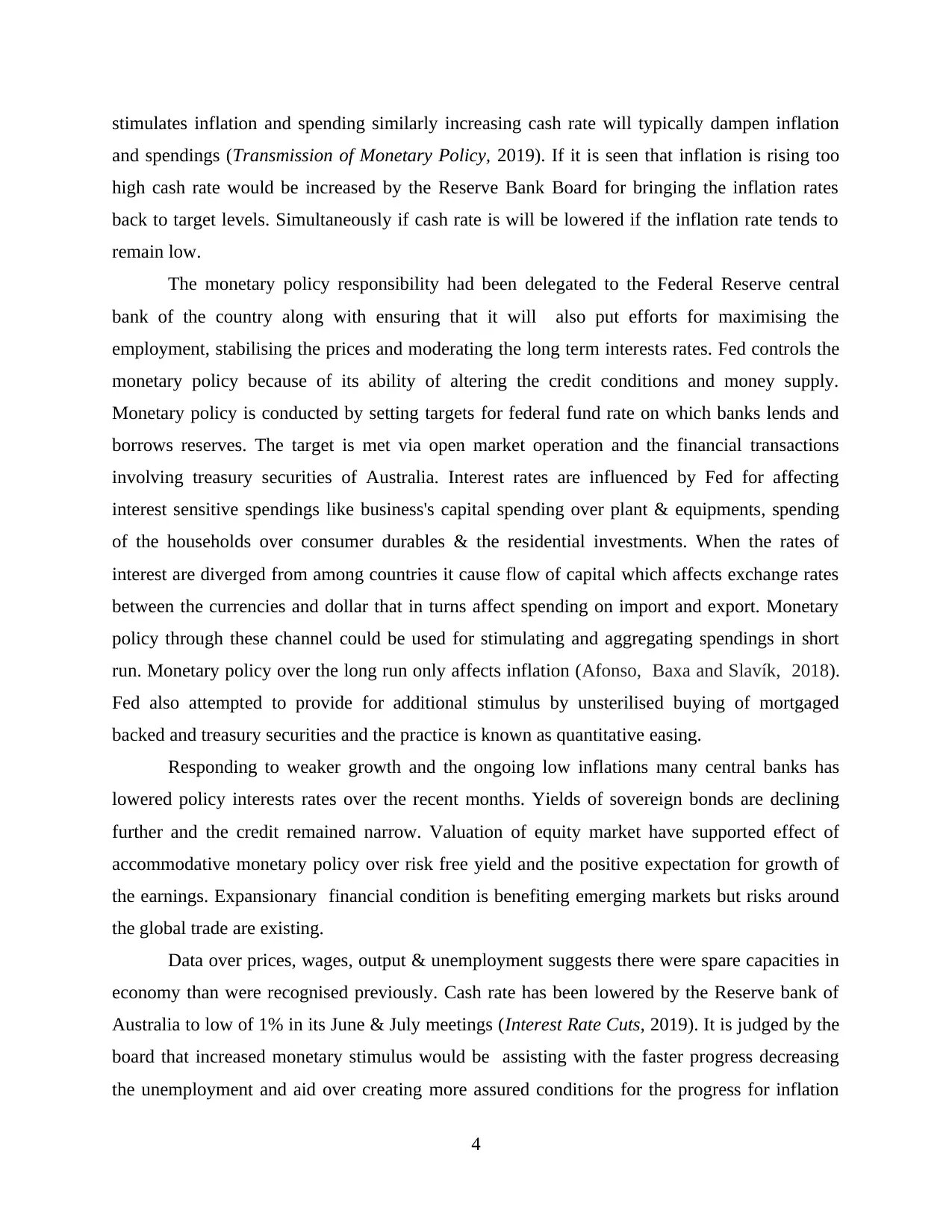
stimulates inflation and spending similarly increasing cash rate will typically dampen inflation
and spendings (Transmission of Monetary Policy, 2019). If it is seen that inflation is rising too
high cash rate would be increased by the Reserve Bank Board for bringing the inflation rates
back to target levels. Simultaneously if cash rate is will be lowered if the inflation rate tends to
remain low.
The monetary policy responsibility had been delegated to the Federal Reserve central
bank of the country along with ensuring that it will also put efforts for maximising the
employment, stabilising the prices and moderating the long term interests rates. Fed controls the
monetary policy because of its ability of altering the credit conditions and money supply.
Monetary policy is conducted by setting targets for federal fund rate on which banks lends and
borrows reserves. The target is met via open market operation and the financial transactions
involving treasury securities of Australia. Interest rates are influenced by Fed for affecting
interest sensitive spendings like business's capital spending over plant & equipments, spending
of the households over consumer durables & the residential investments. When the rates of
interest are diverged from among countries it cause flow of capital which affects exchange rates
between the currencies and dollar that in turns affect spending on import and export. Monetary
policy through these channel could be used for stimulating and aggregating spendings in short
run. Monetary policy over the long run only affects inflation (Afonso, Baxa and Slavík, 2018).
Fed also attempted to provide for additional stimulus by unsterilised buying of mortgaged
backed and treasury securities and the practice is known as quantitative easing.
Responding to weaker growth and the ongoing low inflations many central banks has
lowered policy interests rates over the recent months. Yields of sovereign bonds are declining
further and the credit remained narrow. Valuation of equity market have supported effect of
accommodative monetary policy over risk free yield and the positive expectation for growth of
the earnings. Expansionary financial condition is benefiting emerging markets but risks around
the global trade are existing.
Data over prices, wages, output & unemployment suggests there were spare capacities in
economy than were recognised previously. Cash rate has been lowered by the Reserve bank of
Australia to low of 1% in its June & July meetings (Interest Rate Cuts, 2019). It is judged by the
board that increased monetary stimulus would be assisting with the faster progress decreasing
the unemployment and aid over creating more assured conditions for the progress for inflation
4
and spendings (Transmission of Monetary Policy, 2019). If it is seen that inflation is rising too
high cash rate would be increased by the Reserve Bank Board for bringing the inflation rates
back to target levels. Simultaneously if cash rate is will be lowered if the inflation rate tends to
remain low.
The monetary policy responsibility had been delegated to the Federal Reserve central
bank of the country along with ensuring that it will also put efforts for maximising the
employment, stabilising the prices and moderating the long term interests rates. Fed controls the
monetary policy because of its ability of altering the credit conditions and money supply.
Monetary policy is conducted by setting targets for federal fund rate on which banks lends and
borrows reserves. The target is met via open market operation and the financial transactions
involving treasury securities of Australia. Interest rates are influenced by Fed for affecting
interest sensitive spendings like business's capital spending over plant & equipments, spending
of the households over consumer durables & the residential investments. When the rates of
interest are diverged from among countries it cause flow of capital which affects exchange rates
between the currencies and dollar that in turns affect spending on import and export. Monetary
policy through these channel could be used for stimulating and aggregating spendings in short
run. Monetary policy over the long run only affects inflation (Afonso, Baxa and Slavík, 2018).
Fed also attempted to provide for additional stimulus by unsterilised buying of mortgaged
backed and treasury securities and the practice is known as quantitative easing.
Responding to weaker growth and the ongoing low inflations many central banks has
lowered policy interests rates over the recent months. Yields of sovereign bonds are declining
further and the credit remained narrow. Valuation of equity market have supported effect of
accommodative monetary policy over risk free yield and the positive expectation for growth of
the earnings. Expansionary financial condition is benefiting emerging markets but risks around
the global trade are existing.
Data over prices, wages, output & unemployment suggests there were spare capacities in
economy than were recognised previously. Cash rate has been lowered by the Reserve bank of
Australia to low of 1% in its June & July meetings (Interest Rate Cuts, 2019). It is judged by the
board that increased monetary stimulus would be assisting with the faster progress decreasing
the unemployment and aid over creating more assured conditions for the progress for inflation
4
⊘ This is a preview!⊘
Do you want full access?
Subscribe today to unlock all pages.

Trusted by 1+ million students worldwide
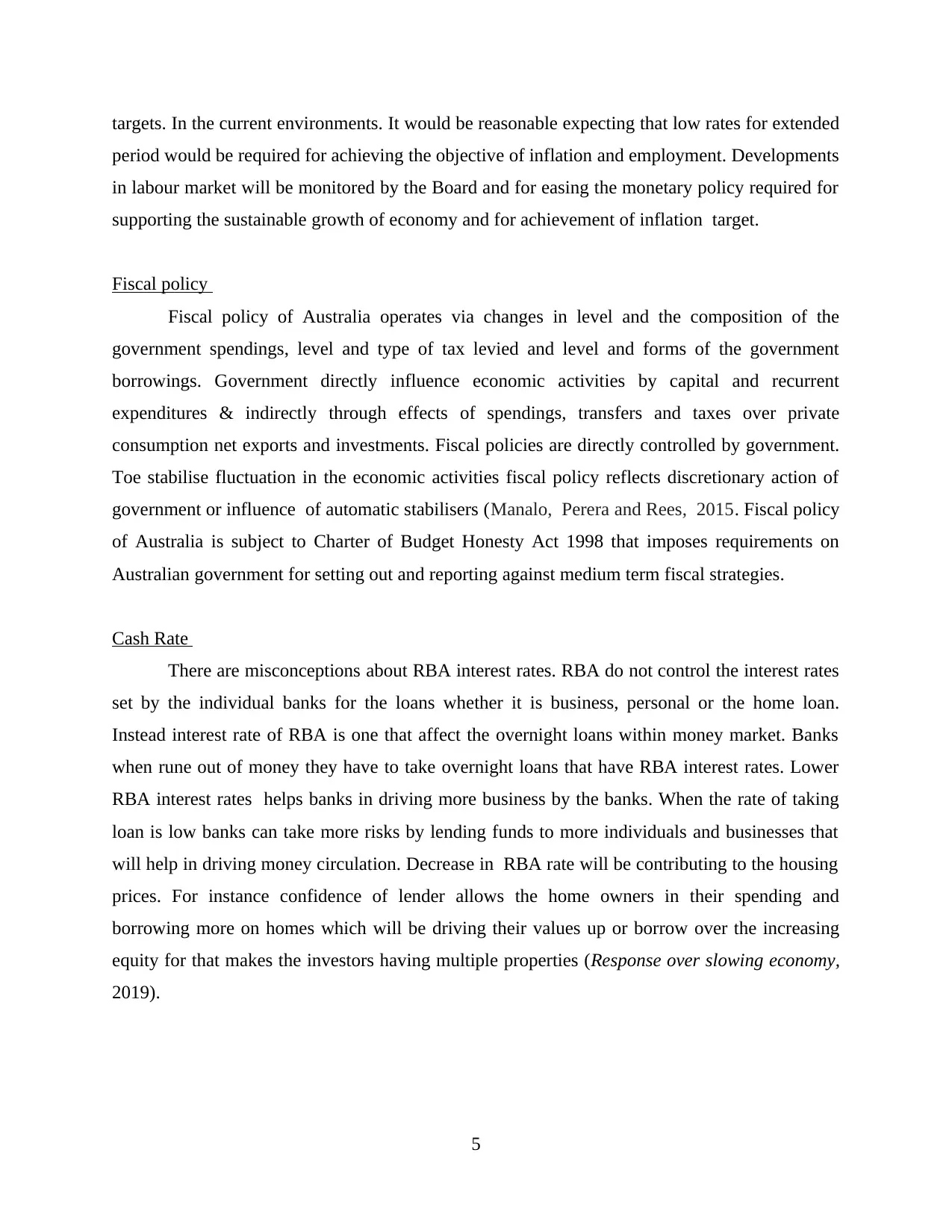
targets. In the current environments. It would be reasonable expecting that low rates for extended
period would be required for achieving the objective of inflation and employment. Developments
in labour market will be monitored by the Board and for easing the monetary policy required for
supporting the sustainable growth of economy and for achievement of inflation target.
Fiscal policy
Fiscal policy of Australia operates via changes in level and the composition of the
government spendings, level and type of tax levied and level and forms of the government
borrowings. Government directly influence economic activities by capital and recurrent
expenditures & indirectly through effects of spendings, transfers and taxes over private
consumption net exports and investments. Fiscal policies are directly controlled by government.
Toe stabilise fluctuation in the economic activities fiscal policy reflects discretionary action of
government or influence of automatic stabilisers (Manalo, Perera and Rees, 2015. Fiscal policy
of Australia is subject to Charter of Budget Honesty Act 1998 that imposes requirements on
Australian government for setting out and reporting against medium term fiscal strategies.
Cash Rate
There are misconceptions about RBA interest rates. RBA do not control the interest rates
set by the individual banks for the loans whether it is business, personal or the home loan.
Instead interest rate of RBA is one that affect the overnight loans within money market. Banks
when rune out of money they have to take overnight loans that have RBA interest rates. Lower
RBA interest rates helps banks in driving more business by the banks. When the rate of taking
loan is low banks can take more risks by lending funds to more individuals and businesses that
will help in driving money circulation. Decrease in RBA rate will be contributing to the housing
prices. For instance confidence of lender allows the home owners in their spending and
borrowing more on homes which will be driving their values up or borrow over the increasing
equity for that makes the investors having multiple properties (Response over slowing economy,
2019).
5
period would be required for achieving the objective of inflation and employment. Developments
in labour market will be monitored by the Board and for easing the monetary policy required for
supporting the sustainable growth of economy and for achievement of inflation target.
Fiscal policy
Fiscal policy of Australia operates via changes in level and the composition of the
government spendings, level and type of tax levied and level and forms of the government
borrowings. Government directly influence economic activities by capital and recurrent
expenditures & indirectly through effects of spendings, transfers and taxes over private
consumption net exports and investments. Fiscal policies are directly controlled by government.
Toe stabilise fluctuation in the economic activities fiscal policy reflects discretionary action of
government or influence of automatic stabilisers (Manalo, Perera and Rees, 2015. Fiscal policy
of Australia is subject to Charter of Budget Honesty Act 1998 that imposes requirements on
Australian government for setting out and reporting against medium term fiscal strategies.
Cash Rate
There are misconceptions about RBA interest rates. RBA do not control the interest rates
set by the individual banks for the loans whether it is business, personal or the home loan.
Instead interest rate of RBA is one that affect the overnight loans within money market. Banks
when rune out of money they have to take overnight loans that have RBA interest rates. Lower
RBA interest rates helps banks in driving more business by the banks. When the rate of taking
loan is low banks can take more risks by lending funds to more individuals and businesses that
will help in driving money circulation. Decrease in RBA rate will be contributing to the housing
prices. For instance confidence of lender allows the home owners in their spending and
borrowing more on homes which will be driving their values up or borrow over the increasing
equity for that makes the investors having multiple properties (Response over slowing economy,
2019).
5
Paraphrase This Document
Need a fresh take? Get an instant paraphrase of this document with our AI Paraphraser
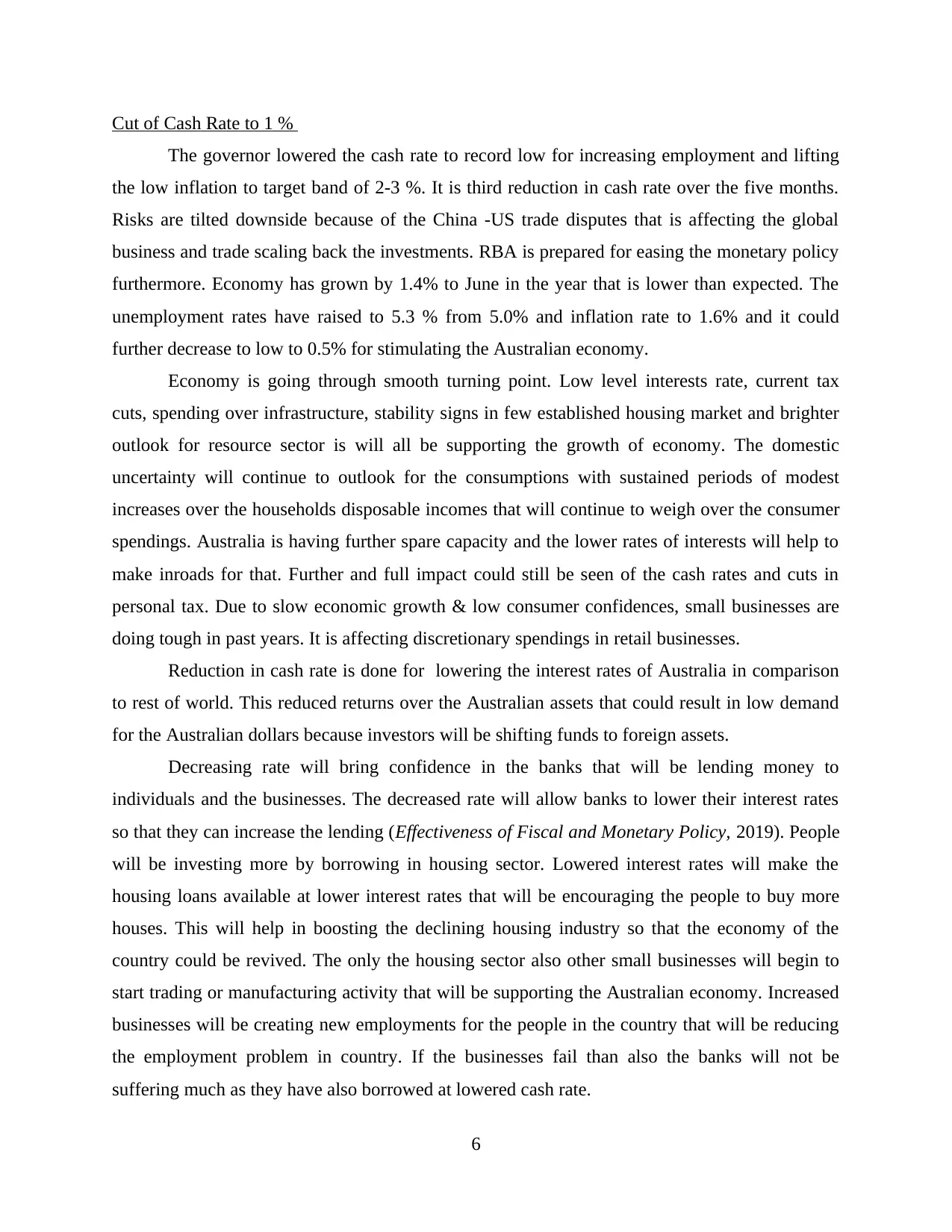
Cut of Cash Rate to 1 %
The governor lowered the cash rate to record low for increasing employment and lifting
the low inflation to target band of 2-3 %. It is third reduction in cash rate over the five months.
Risks are tilted downside because of the China -US trade disputes that is affecting the global
business and trade scaling back the investments. RBA is prepared for easing the monetary policy
furthermore. Economy has grown by 1.4% to June in the year that is lower than expected. The
unemployment rates have raised to 5.3 % from 5.0% and inflation rate to 1.6% and it could
further decrease to low to 0.5% for stimulating the Australian economy.
Economy is going through smooth turning point. Low level interests rate, current tax
cuts, spending over infrastructure, stability signs in few established housing market and brighter
outlook for resource sector is will all be supporting the growth of economy. The domestic
uncertainty will continue to outlook for the consumptions with sustained periods of modest
increases over the households disposable incomes that will continue to weigh over the consumer
spendings. Australia is having further spare capacity and the lower rates of interests will help to
make inroads for that. Further and full impact could still be seen of the cash rates and cuts in
personal tax. Due to slow economic growth & low consumer confidences, small businesses are
doing tough in past years. It is affecting discretionary spendings in retail businesses.
Reduction in cash rate is done for lowering the interest rates of Australia in comparison
to rest of world. This reduced returns over the Australian assets that could result in low demand
for the Australian dollars because investors will be shifting funds to foreign assets.
Decreasing rate will bring confidence in the banks that will be lending money to
individuals and the businesses. The decreased rate will allow banks to lower their interest rates
so that they can increase the lending (Effectiveness of Fiscal and Monetary Policy, 2019). People
will be investing more by borrowing in housing sector. Lowered interest rates will make the
housing loans available at lower interest rates that will be encouraging the people to buy more
houses. This will help in boosting the declining housing industry so that the economy of the
country could be revived. The only the housing sector also other small businesses will begin to
start trading or manufacturing activity that will be supporting the Australian economy. Increased
businesses will be creating new employments for the people in the country that will be reducing
the employment problem in country. If the businesses fail than also the banks will not be
suffering much as they have also borrowed at lowered cash rate.
6
The governor lowered the cash rate to record low for increasing employment and lifting
the low inflation to target band of 2-3 %. It is third reduction in cash rate over the five months.
Risks are tilted downside because of the China -US trade disputes that is affecting the global
business and trade scaling back the investments. RBA is prepared for easing the monetary policy
furthermore. Economy has grown by 1.4% to June in the year that is lower than expected. The
unemployment rates have raised to 5.3 % from 5.0% and inflation rate to 1.6% and it could
further decrease to low to 0.5% for stimulating the Australian economy.
Economy is going through smooth turning point. Low level interests rate, current tax
cuts, spending over infrastructure, stability signs in few established housing market and brighter
outlook for resource sector is will all be supporting the growth of economy. The domestic
uncertainty will continue to outlook for the consumptions with sustained periods of modest
increases over the households disposable incomes that will continue to weigh over the consumer
spendings. Australia is having further spare capacity and the lower rates of interests will help to
make inroads for that. Further and full impact could still be seen of the cash rates and cuts in
personal tax. Due to slow economic growth & low consumer confidences, small businesses are
doing tough in past years. It is affecting discretionary spendings in retail businesses.
Reduction in cash rate is done for lowering the interest rates of Australia in comparison
to rest of world. This reduced returns over the Australian assets that could result in low demand
for the Australian dollars because investors will be shifting funds to foreign assets.
Decreasing rate will bring confidence in the banks that will be lending money to
individuals and the businesses. The decreased rate will allow banks to lower their interest rates
so that they can increase the lending (Effectiveness of Fiscal and Monetary Policy, 2019). People
will be investing more by borrowing in housing sector. Lowered interest rates will make the
housing loans available at lower interest rates that will be encouraging the people to buy more
houses. This will help in boosting the declining housing industry so that the economy of the
country could be revived. The only the housing sector also other small businesses will begin to
start trading or manufacturing activity that will be supporting the Australian economy. Increased
businesses will be creating new employments for the people in the country that will be reducing
the employment problem in country. If the businesses fail than also the banks will not be
suffering much as they have also borrowed at lowered cash rate.
6
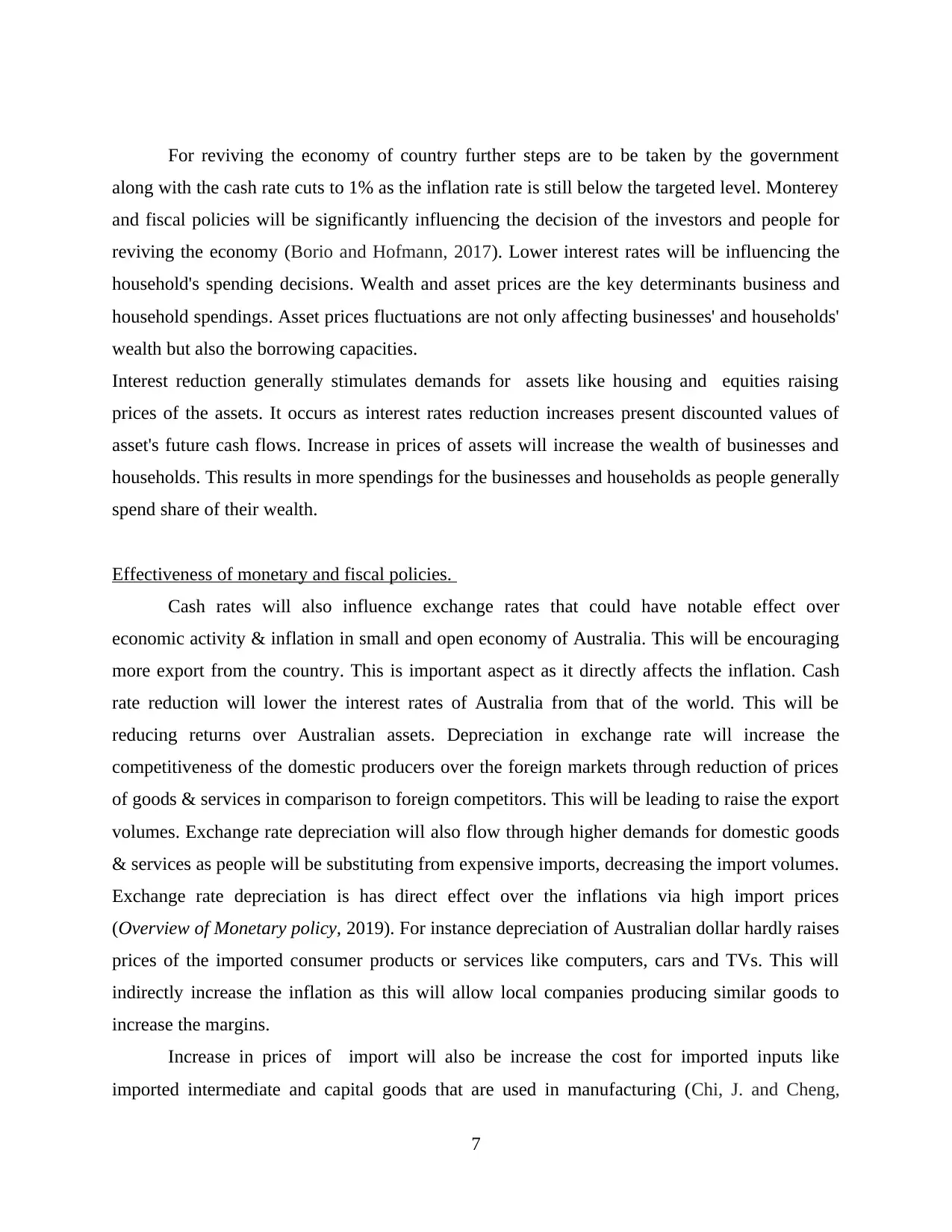
For reviving the economy of country further steps are to be taken by the government
along with the cash rate cuts to 1% as the inflation rate is still below the targeted level. Monterey
and fiscal policies will be significantly influencing the decision of the investors and people for
reviving the economy (Borio and Hofmann, 2017). Lower interest rates will be influencing the
household's spending decisions. Wealth and asset prices are the key determinants business and
household spendings. Asset prices fluctuations are not only affecting businesses' and households'
wealth but also the borrowing capacities.
Interest reduction generally stimulates demands for assets like housing and equities raising
prices of the assets. It occurs as interest rates reduction increases present discounted values of
asset's future cash flows. Increase in prices of assets will increase the wealth of businesses and
households. This results in more spendings for the businesses and households as people generally
spend share of their wealth.
Effectiveness of monetary and fiscal policies.
Cash rates will also influence exchange rates that could have notable effect over
economic activity & inflation in small and open economy of Australia. This will be encouraging
more export from the country. This is important aspect as it directly affects the inflation. Cash
rate reduction will lower the interest rates of Australia from that of the world. This will be
reducing returns over Australian assets. Depreciation in exchange rate will increase the
competitiveness of the domestic producers over the foreign markets through reduction of prices
of goods & services in comparison to foreign competitors. This will be leading to raise the export
volumes. Exchange rate depreciation will also flow through higher demands for domestic goods
& services as people will be substituting from expensive imports, decreasing the import volumes.
Exchange rate depreciation is has direct effect over the inflations via high import prices
(Overview of Monetary policy, 2019). For instance depreciation of Australian dollar hardly raises
prices of the imported consumer products or services like computers, cars and TVs. This will
indirectly increase the inflation as this will allow local companies producing similar goods to
increase the margins.
Increase in prices of import will also be increase the cost for imported inputs like
imported intermediate and capital goods that are used in manufacturing (Chi, J. and Cheng,
7
along with the cash rate cuts to 1% as the inflation rate is still below the targeted level. Monterey
and fiscal policies will be significantly influencing the decision of the investors and people for
reviving the economy (Borio and Hofmann, 2017). Lower interest rates will be influencing the
household's spending decisions. Wealth and asset prices are the key determinants business and
household spendings. Asset prices fluctuations are not only affecting businesses' and households'
wealth but also the borrowing capacities.
Interest reduction generally stimulates demands for assets like housing and equities raising
prices of the assets. It occurs as interest rates reduction increases present discounted values of
asset's future cash flows. Increase in prices of assets will increase the wealth of businesses and
households. This results in more spendings for the businesses and households as people generally
spend share of their wealth.
Effectiveness of monetary and fiscal policies.
Cash rates will also influence exchange rates that could have notable effect over
economic activity & inflation in small and open economy of Australia. This will be encouraging
more export from the country. This is important aspect as it directly affects the inflation. Cash
rate reduction will lower the interest rates of Australia from that of the world. This will be
reducing returns over Australian assets. Depreciation in exchange rate will increase the
competitiveness of the domestic producers over the foreign markets through reduction of prices
of goods & services in comparison to foreign competitors. This will be leading to raise the export
volumes. Exchange rate depreciation will also flow through higher demands for domestic goods
& services as people will be substituting from expensive imports, decreasing the import volumes.
Exchange rate depreciation is has direct effect over the inflations via high import prices
(Overview of Monetary policy, 2019). For instance depreciation of Australian dollar hardly raises
prices of the imported consumer products or services like computers, cars and TVs. This will
indirectly increase the inflation as this will allow local companies producing similar goods to
increase the margins.
Increase in prices of import will also be increase the cost for imported inputs like
imported intermediate and capital goods that are used in manufacturing (Chi, J. and Cheng,
7
⊘ This is a preview!⊘
Do you want full access?
Subscribe today to unlock all pages.

Trusted by 1+ million students worldwide
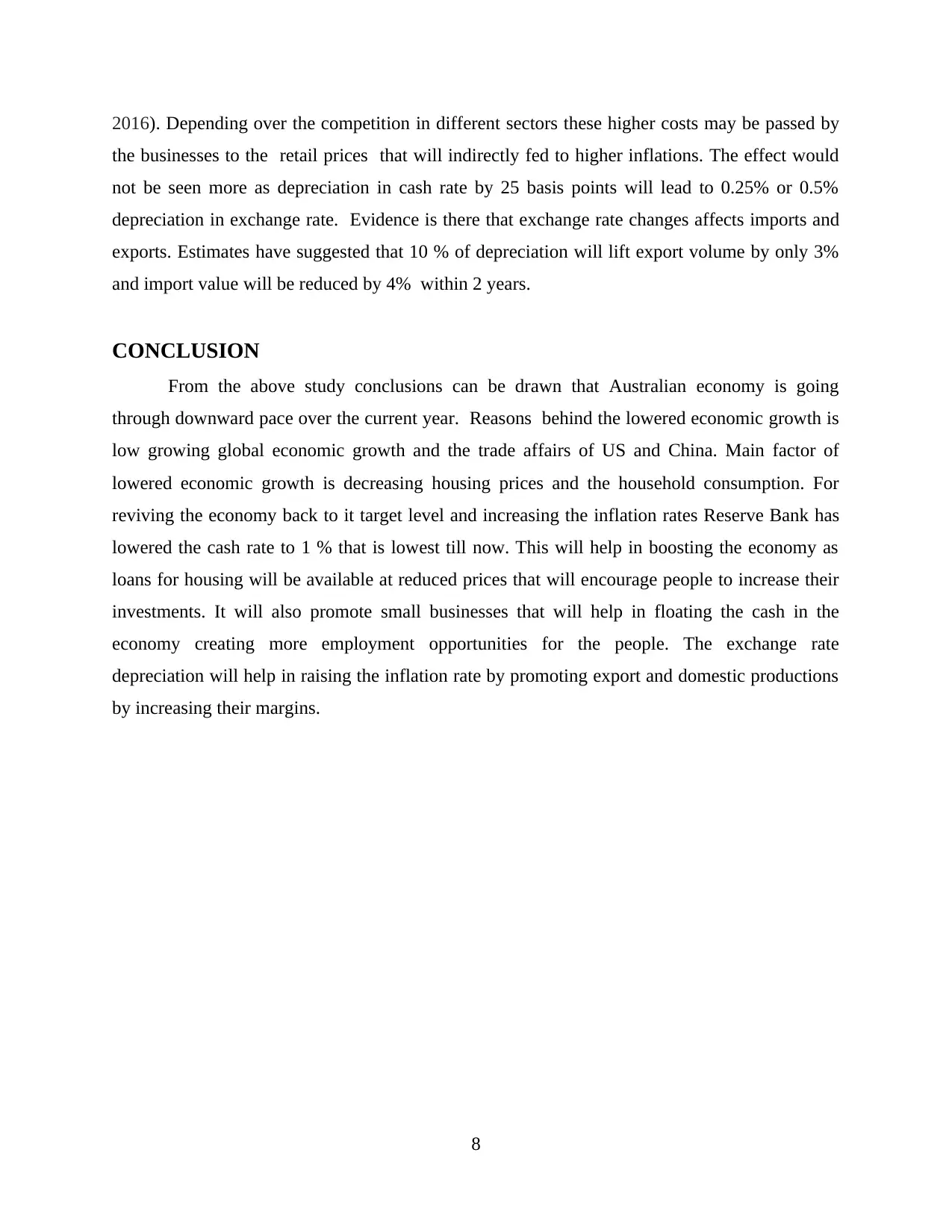
2016). Depending over the competition in different sectors these higher costs may be passed by
the businesses to the retail prices that will indirectly fed to higher inflations. The effect would
not be seen more as depreciation in cash rate by 25 basis points will lead to 0.25% or 0.5%
depreciation in exchange rate. Evidence is there that exchange rate changes affects imports and
exports. Estimates have suggested that 10 % of depreciation will lift export volume by only 3%
and import value will be reduced by 4% within 2 years.
CONCLUSION
From the above study conclusions can be drawn that Australian economy is going
through downward pace over the current year. Reasons behind the lowered economic growth is
low growing global economic growth and the trade affairs of US and China. Main factor of
lowered economic growth is decreasing housing prices and the household consumption. For
reviving the economy back to it target level and increasing the inflation rates Reserve Bank has
lowered the cash rate to 1 % that is lowest till now. This will help in boosting the economy as
loans for housing will be available at reduced prices that will encourage people to increase their
investments. It will also promote small businesses that will help in floating the cash in the
economy creating more employment opportunities for the people. The exchange rate
depreciation will help in raising the inflation rate by promoting export and domestic productions
by increasing their margins.
8
the businesses to the retail prices that will indirectly fed to higher inflations. The effect would
not be seen more as depreciation in cash rate by 25 basis points will lead to 0.25% or 0.5%
depreciation in exchange rate. Evidence is there that exchange rate changes affects imports and
exports. Estimates have suggested that 10 % of depreciation will lift export volume by only 3%
and import value will be reduced by 4% within 2 years.
CONCLUSION
From the above study conclusions can be drawn that Australian economy is going
through downward pace over the current year. Reasons behind the lowered economic growth is
low growing global economic growth and the trade affairs of US and China. Main factor of
lowered economic growth is decreasing housing prices and the household consumption. For
reviving the economy back to it target level and increasing the inflation rates Reserve Bank has
lowered the cash rate to 1 % that is lowest till now. This will help in boosting the economy as
loans for housing will be available at reduced prices that will encourage people to increase their
investments. It will also promote small businesses that will help in floating the cash in the
economy creating more employment opportunities for the people. The exchange rate
depreciation will help in raising the inflation rate by promoting export and domestic productions
by increasing their margins.
8
Paraphrase This Document
Need a fresh take? Get an instant paraphrase of this document with our AI Paraphraser

REFERENCES
Books and Journals
Bell, S., 2017. Great Ideas of Central Banking: Values, Ideas and the Transformation of Central
Banking and Monetary Policy in Australia. In Government Reformed. (pp. 23-42).
Routledge.
Neely, C.J., 2015. Unconventional monetary policy had large international effects. Journal of
Banking & Finance. 52. pp.101-111.
La Cava, G., Hughson, H. and Kaplan, G., 2016. The household cash flow channel of monetary
policy. Reserve Bank of Australia, Research Discussion Papers. 12.
Wu, J.C. and Xia, F.D., 2016. Measuring the macroeconomic impact of monetary policy at the
zero lower bound. Journal of Money, Credit and Banking. 48(2-3). pp.253-291.
Afonso, A., Baxa, J. and Slavík, M., 2018. Fiscal developments and financial stress: a threshold
VAR analysis. Empirical Economics. 54(2). pp.395-423.
Manalo, J., Perera, D. and Rees, D.M., 2015. Exchange rate movements and the Australian
economy. Economic Modelling. 47. pp.53-62.
Chi, J. and Cheng, S.K., 2016. Do exchange rate volatility and income affect Australia’s
maritime export flows to Asia?. Transport Policy. 47. pp.13-21.
Borio, C.E. and Hofmann, B., 2017. Is monetary policy less effective when interest rates are
persistently low?.
Online
Statement on Monetary Policy. 2019. [Online]. Available through :
<https://www.rba.gov.au/publications/smp/2019/aug/>.
Economic Outlook and Monetary policy. 2019. [Online]. Available through :
<https://www.rba.gov.au/speeches/2019/sp-gov-2019-05-21.html>.
Transmission of Monetary Policy. 2019. [Online]. Available through :
<https://www.rba.gov.au/publications/bulletin/2017/sep/1.html>.
9
Books and Journals
Bell, S., 2017. Great Ideas of Central Banking: Values, Ideas and the Transformation of Central
Banking and Monetary Policy in Australia. In Government Reformed. (pp. 23-42).
Routledge.
Neely, C.J., 2015. Unconventional monetary policy had large international effects. Journal of
Banking & Finance. 52. pp.101-111.
La Cava, G., Hughson, H. and Kaplan, G., 2016. The household cash flow channel of monetary
policy. Reserve Bank of Australia, Research Discussion Papers. 12.
Wu, J.C. and Xia, F.D., 2016. Measuring the macroeconomic impact of monetary policy at the
zero lower bound. Journal of Money, Credit and Banking. 48(2-3). pp.253-291.
Afonso, A., Baxa, J. and Slavík, M., 2018. Fiscal developments and financial stress: a threshold
VAR analysis. Empirical Economics. 54(2). pp.395-423.
Manalo, J., Perera, D. and Rees, D.M., 2015. Exchange rate movements and the Australian
economy. Economic Modelling. 47. pp.53-62.
Chi, J. and Cheng, S.K., 2016. Do exchange rate volatility and income affect Australia’s
maritime export flows to Asia?. Transport Policy. 47. pp.13-21.
Borio, C.E. and Hofmann, B., 2017. Is monetary policy less effective when interest rates are
persistently low?.
Online
Statement on Monetary Policy. 2019. [Online]. Available through :
<https://www.rba.gov.au/publications/smp/2019/aug/>.
Economic Outlook and Monetary policy. 2019. [Online]. Available through :
<https://www.rba.gov.au/speeches/2019/sp-gov-2019-05-21.html>.
Transmission of Monetary Policy. 2019. [Online]. Available through :
<https://www.rba.gov.au/publications/bulletin/2017/sep/1.html>.
9
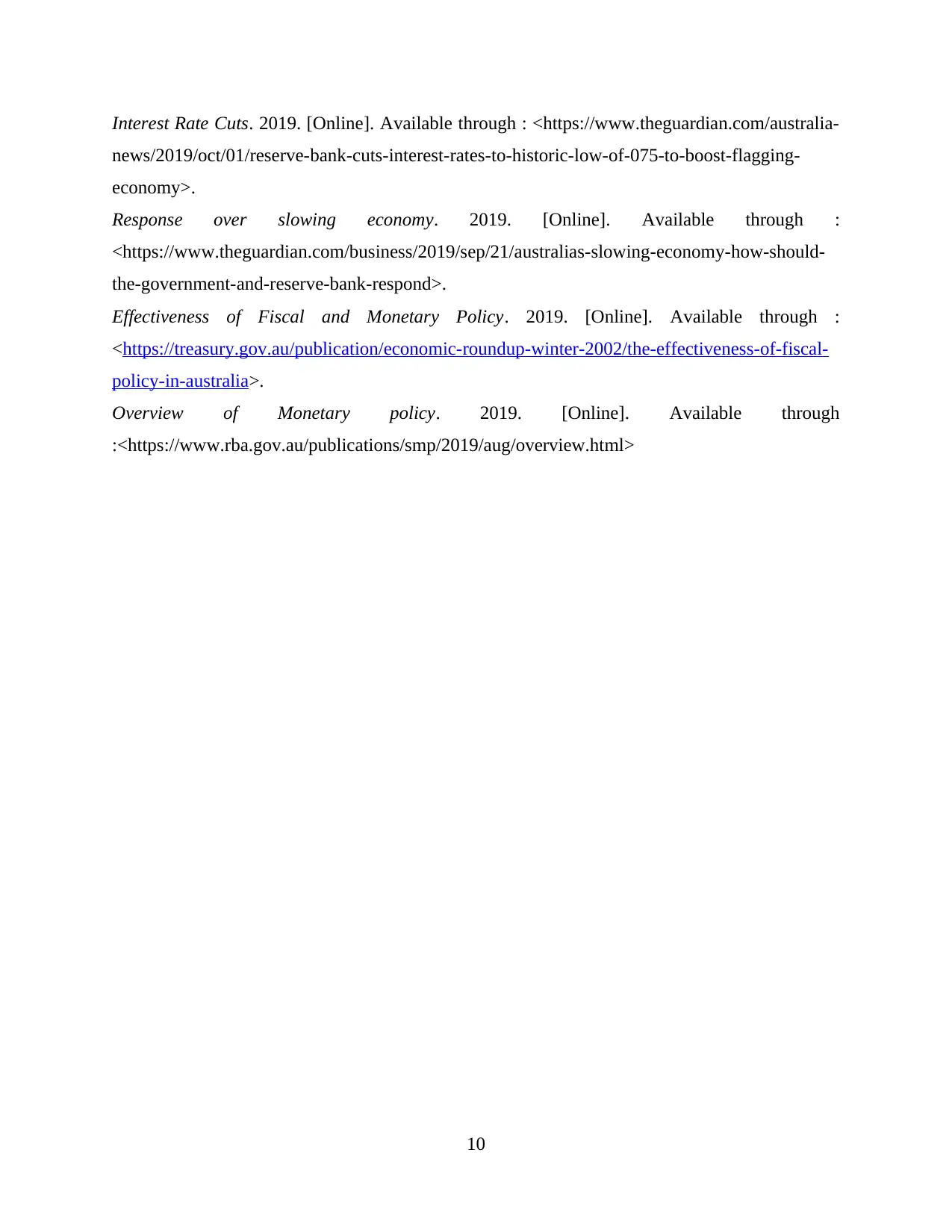
Interest Rate Cuts. 2019. [Online]. Available through : <https://www.theguardian.com/australia-
news/2019/oct/01/reserve-bank-cuts-interest-rates-to-historic-low-of-075-to-boost-flagging-
economy>.
Response over slowing economy. 2019. [Online]. Available through :
<https://www.theguardian.com/business/2019/sep/21/australias-slowing-economy-how-should-
the-government-and-reserve-bank-respond>.
Effectiveness of Fiscal and Monetary Policy. 2019. [Online]. Available through :
<https://treasury.gov.au/publication/economic-roundup-winter-2002/the-effectiveness-of-fiscal-
policy-in-australia>.
Overview of Monetary policy. 2019. [Online]. Available through
:<https://www.rba.gov.au/publications/smp/2019/aug/overview.html>
10
news/2019/oct/01/reserve-bank-cuts-interest-rates-to-historic-low-of-075-to-boost-flagging-
economy>.
Response over slowing economy. 2019. [Online]. Available through :
<https://www.theguardian.com/business/2019/sep/21/australias-slowing-economy-how-should-
the-government-and-reserve-bank-respond>.
Effectiveness of Fiscal and Monetary Policy. 2019. [Online]. Available through :
<https://treasury.gov.au/publication/economic-roundup-winter-2002/the-effectiveness-of-fiscal-
policy-in-australia>.
Overview of Monetary policy. 2019. [Online]. Available through
:<https://www.rba.gov.au/publications/smp/2019/aug/overview.html>
10
⊘ This is a preview!⊘
Do you want full access?
Subscribe today to unlock all pages.

Trusted by 1+ million students worldwide
1 out of 12
Related Documents
Your All-in-One AI-Powered Toolkit for Academic Success.
+13062052269
info@desklib.com
Available 24*7 on WhatsApp / Email
![[object Object]](/_next/static/media/star-bottom.7253800d.svg)
Unlock your academic potential
Copyright © 2020–2025 A2Z Services. All Rights Reserved. Developed and managed by ZUCOL.




